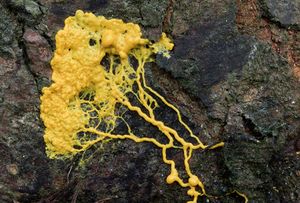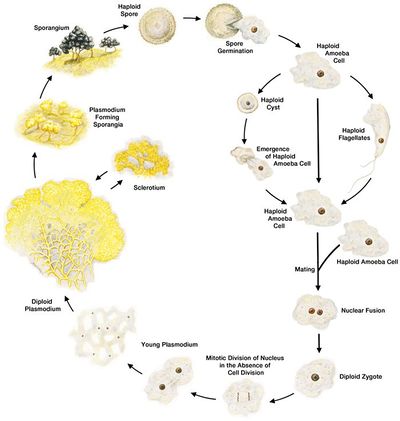Physarum polycephalum
Introduction

Physarum polycephalum is a species of acellular slime molds, or myxomycetes. Despite having a similar name to fungi, these organisms are protists. They are most commonly found in soil, moist vegetation, and the forest floor where it is cool, damp, and dark, where they contribute to the decomposition of dead vegetation. P. polycephalum have very diverse forms of life in a single cycle, as they can range from being a microscopic single-celled amoeba, a multinucleated cell, or plasmodium, that can span several feet, morphing into a hardened mass known as a sclerotium, or forming small, delicate fruiting bodies that produce haploid spores.
Due to its unique life cycle and large plasmodium stage, P. polycephalum is used as a model organism for the studies of cell cycle regulation, cell differentiation, and cellular motility. A multitude of studies have been done on this species of slime mold in order to research and comprehend its methods of communication and apparent intelligence. It is currently unknown as to what the molecular and genetic properties of this organism are that make it capable of having awareness and decision making, as further studies are currently in the process of obtaining conclusive results.
Life Cycle

[1]
The P. Polycephalum undergoes many changes during its life. The formation of its cycles is dependent upon environmental stressors and the presence or absence of other Physarum{3}
Plasmodium
The most commonly observed form of the Physarum polycephalum is its plasmodial form. The plasmodium is a large, singular cell with multiple diploid nuclei, as it grows without the process of cytokinesis. These single cells can grow to a diameter of over a foot long as they continue to grow via the consumption of bacteria, fungal spores, and dead organic matter in its wild environment. When in nutrient-rich agar or other liquid cultures, plasmodium cells will readily grow axenically, no longer needing to engulf microbes to aid in the decomposition of organic matter.
Sclerotium
In the absence of light, the plasmodium will revert into a temporary and reversible dormant state known as a sclerotium.
Sporangia
If a starving plasmodium is in the presence of light, it will differentiate into sporangia. Unlike the dormant state of the sclerotium, sporangia is an irreversible pathway that the plasmodium transitions into.
Behavioral Characteristics
Optimal Foraging
Cytoplasmic Streaming
Conclusion
Physarum polycephalum appear to exhibit communication and intelligence, unlike most organisms.
References
Edited by Freya Beinart, student of Joan Slonczewski for BIOL 116 Information in Living Systems, 2020, Kenyon College.
